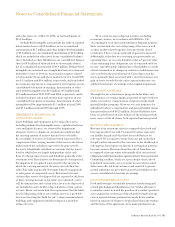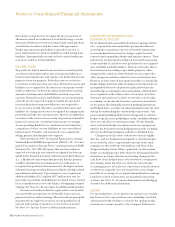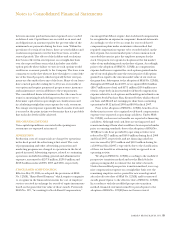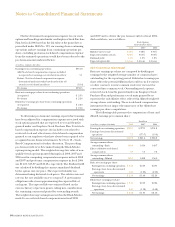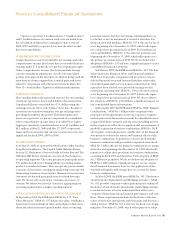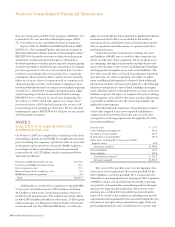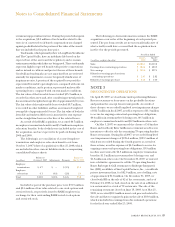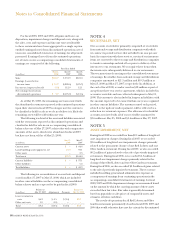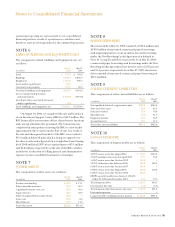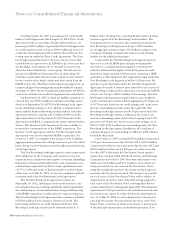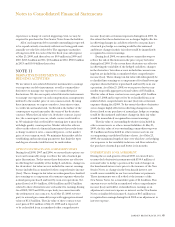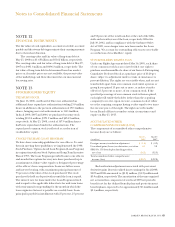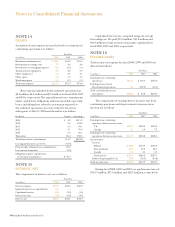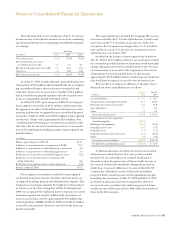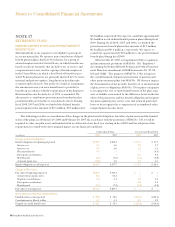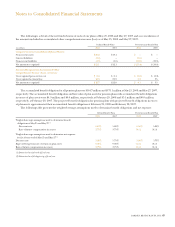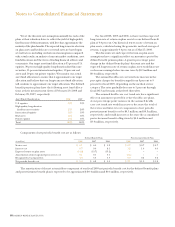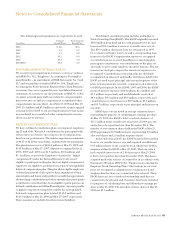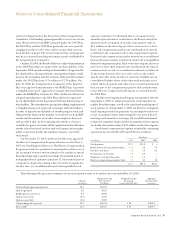Red Lobster 2008 Annual Report Download - page 65
Download and view the complete annual report
Please find page 65 of the 2008 Red Lobster annual report below. You can navigate through the pages in the report by either clicking on the pages listed below, or by using the keyword search tool below to find specific information within the annual report.Notes to Consolidated Financial Statements
DARDEN RESTAURANTS, INC. 61
experience a change of control triggering event, we may be
required to purchase the New Senior Notes from the holders.
All of our long-term debt currently outstanding is expected
to be repaid entirely at maturity with interest being paid semi-
annually over the life of the debt. The aggregate maturities
of long-term debt for each of the five fiscal years subsequent
to May 25, 2008, and thereafter are $0.0 million in 2009 and
2010, $225.0 million in 2011, $0.0 million in 2012, $350.0 million
in 2013 and $1.06 billion thereafter.
NOTE 11
DERIVATIVE INSTRUMENTS AND
HEDGING ACTIVITIES
We use interest rate-related derivative instruments to manage
our exposure on debt instruments, as well as commodities
derivatives to manage our exposure to commodity price
fluctuations. We also use equity-related derivative instruments
to manage our exposure on cash compensation arrangements
indexed to the market price of our common stock. By using
these instruments, we expose ourselves, from time to time,
to credit risk and market risk. Credit risk is the failure of the
counterparty to perform under the terms of the derivative
contract. When the fair value of a derivative contract is posi-
tive, the counterparty owes us, which creates credit risk for
us. We minimize this credit risk by entering into transactions
with high quality counterparties. Market risk is the adverse
effect on the value of a financial instrument that results from
a change in interest rates, commodity prices, or the market
price of our common stock. We minimize this market risk by
establishing and monitoring parameters that limit the types
and degree of market risk that may be undertaken.
OPTION CONTRACTS AND COMMODITY SWAPS
During fiscal 2008, 2007 and 2006, we entered into option con-
tracts and commodity swaps to reduce the risk of natural gas
price fluctuations. To the extent these derivatives are effective
in offsetting the variability of the hedged cash flows, changes in
the derivatives’ fair value are not included in current earnings
but are included in accumulated other comprehensive income
(loss). These changes in fair value are subsequently reclassified
into earnings as a component of restaurant expenses when the
natural gas is purchased and used by us in our operations. Net
gains (losses) of $0.4 million, ($4.6) million and $4.3 million
related to these derivatives were reclassified to earnings during
fiscal 2008, 2007 and 2006, respectively, in connection with
the settlement of our contracts. As of May 25, 2008, we were
party to natural gas commodity swaps with aggregate notional
values of $11.3 million. The fair value of these contracts was
a net gain of $0.1 million at May 25, 2008 and is expected
to be reclassified from accumulated other comprehensive
income (loss) into restaurant expenses during fiscal 2009. To
the extent that these derivatives are no longer highly effective
in offsetting changes in cash flows related to our purchases
of natural gas, hedge accounting would be discontinued
and future changes in their fair value would be immediately
recognized in current earnings.
During fiscal 2008, we entered into commodity swaps to
reduce the risk of fluctuations in the price we pay for butter
during fiscal 2009. To the extent these derivatives are effective
in offsetting the variability of the hedged cash flows, changes
in the derivatives’ fair value are not included in current earn-
ings but are included in accumulated other comprehensive
income (loss). These changes in fair value will subsequently be
reclassified into earnings as a component of food and beverage
expenses when the butter is purchased and used by us in our
operations. As of May 25, 2008, we were party to butter com-
modity swaps with aggregate notional values of $5.8 million.
The fair value of these contracts was a net gain of $0.1 million
at May 25, 2008 and is expected to be reclassified from accu-
mulated other comprehensive income (loss) into restaurant
expenses during fiscal 2009. To the extent that these derivatives
are no longer highly effective in offsetting changes in cash
flows related to our purchases of natural gas, hedge accounting
would be discontinued and future changes in their fair value
would be immediately recognized in current earnings.
The fair value of outstanding derivatives is included in
other current assets or other current liabilities. At May 25,
2008, the fair value of our outstanding commodity swaps was
$0.2 million and is included in other current assets in our
accompanying consolidated balance sheets. As of May 25,
2008, the maximum length of time over which we are hedging
our exposure to the variability in future cash flows related to
the purchase of natural gas and butter is six months.
INTEREST RATE LOCK AGREEMENT
During the second quarter of fiscal 2008, we entered into
treasury-lock derivative instruments with $550.0 million of
notional value to hedge a portion of the risk of changes in
the benchmark interest rate prior to the issuance of the New
Senior Notes, as changes in the benchmark interest rate
would cause variability in our forecasted interest payments.
These instruments were all settled at the issuance of the
New Senior Notes for a cumulative gain of $6.2 million. This
amount was recorded in accumulated other comprehensive
income (loss) and will be reclassified into earnings as an
adjustment to interest expense as interest on the New Senior
Notes or similar debt is incurred. A gain of $0.5 million was
recognized in earnings during fiscal 2008 as an adjustment to
interest expense.


